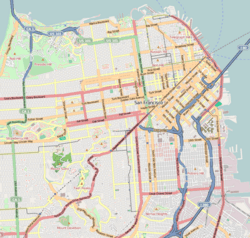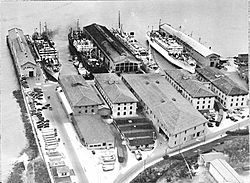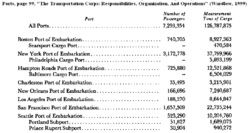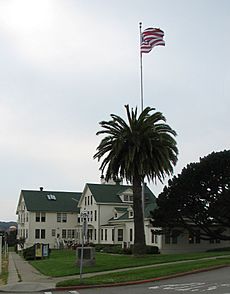Fort Mason facts for kids
|
San Francisco Port of Embarkation, US Army
|
|

Historic wharves at Lower Fort Mason, viewed from Upper Fort Mason
|
|
| Location | San Francisco, California |
|---|---|
| Area | 21 acres (8.5 ha) (landmarked area) |
| Built | 1912 |
| NRHP reference No. | 85002433 |
Quick facts for kids Significant dates |
|
| Added to NRHP | February 4, 1985 |
| Designated NHLD | February 4, 1985 |
Fort Mason, in San Francisco, California is a former United States Army post located in the northern Marina District, alongside San Francisco Bay. Fort Mason served as an Army post for more than 100 years, initially as a coastal defense site and subsequently as a military port facility. During World War II, it was the principal port for the Pacific campaign.
Fort Mason originated as a coastal defense site during the American Civil War. The nucleus of the property was owned by John C. Frémont and disputes over compensation by the United States continued into 1968. In 1882 the defenses were named for Richard Barnes Mason, a military governor before statehood. Fort Mason became the headquarters for an Army command that included California and the Hawaiian Islands from 1904 to 1907. In 1912 the Army began building a port facility with piers and warehouses to be a home base for ships of the Army Transport Service serving Alaska, Hawaii, the Philippines and other Pacific Army posts and focus of Army supply for the Pacific.
On 6 May 1932 that port facility was designated the San Francisco Port of Embarkation, modeled on the New York Port of Embarkation which supplied U.S. Army forces in World War I, to serve the Pacific. Fort Mason then became both the headquarters of the command that was the San Francisco Port of Embarkation and an element of that command. The San Francisco Port of Embarkation assumed responsibility for the Army Transport Service, the San Francisco General Quartermaster Depot at Fort Mason and the Overseas Replacement and Discharge Service at Fort McDowell, California. When war came to Europe in 1939 the New York Port of Embarkation was again operating as a port of embarkation on a World War I scale with associated camps and facilities and sub ports soon to be established. On the Pacific only the port at San Francisco was operating. The Army recognized that the relatively small port facility at Fort Mason was inadequate for supporting major wartime operations in the Pacific. In early 1941 the Army began acquiring land and facilities for major expansion in Oakland, Seattle and elsewhere in the San Francisco area. By the end of the war Fort Mason and thirteen other facilities composed the San Francisco Port of Embarkation.
The San Francisco Port of Embarkation was the second largest of eight Ports of Embarkation through World War II and was disestablished 1 October 1955. It then became headquarters for the Pacific Transportation Terminal Command.
Today it is part of the Golden Gate National Recreation Area and the site of several cultural facilities. The entire fort area is listed as a historic district on the National Register of Historic Places, with 49 buildings of historic significance, spread over 1,200 acres (490 ha). while the lower port area is a National Historic Landmark District, designated for its role in World War II.
Contents
Geography
Fort Mason can be split into two distinct areas. The upper area, sometimes called Fort Mason, is situated on a headland and was the site of the original coastal fortifications. The lower area, Fort Mason Center, is situated close to water level to the west of Upper Fort Mason, and is the site of the former military port, with its piers and warehouses. The Marina Green lies to the west of Fort Mason, while Aquatic Park is to the east.
History
Earlier private ownership by John C. Frémont
The nucleus of Fort Mason was a private property owned by John C. Frémont, the explorer of the western U.S., who also spearheaded the conquest of California from Mexico, and ran as the first presidential nominee of the extant Republican Party in 1856. As alleged in a 1968 federal lawsuit filed by his descendants over the 70-acre parcel then at issue, Frémont bought a 13.5-acre property in the mid-1850s for $42,000, and then improved it by about $40,000.
Appointed a major general in the Union army at the start of the Civil War, Frémont's repeated serious conflicts with President Lincoln led him to resign by late 1862. In 1863, the government seized the property without payment, by executive order of Lincoln, on the grounds it was needed for the war effort. Frémont would again contest the US presidency in 1864, running as the candidate of Radical Democracy Party, only resigning the effort when Lincoln fired a political enemy in his cabinet as a concession.
The 1968 lawsuit was perhaps the last shot of a century-long legal struggle to obtain compensation for the seized realty. In 1870, the government returned property to 49 parties in the vicinity, but not to Frémont and a few others. At that time, Frémont was still very preoccupied with enough of the vast fortune he had made through gold-mining before the Civil War that the matter was unlikely of concern to him; but by 1872 he was in grave financial trouble he would never escape before his death in 1890. Over the years, at least 24 Congressional committees would vote to compensate Frémont, and finally in February 1898 President William McKinley signed a bill directing that the court of claims fix the compensation due. But in 1968 the Frémont heirs complained it had failed to carry out this direction, with John Frémont then recently dead and his widow Jessie over 70 years old.
Current uses

Some of the old officer housing remains in use by the Army, while some is rented to the public. One of the larger buildings has been converted into a youth hostel, operated by Hostelling International USA.
As a whole, the former post is now a mix of parks and gardens and late nineteenth and early twentieth century buildings that are still in use. A path follows the harbor edge, rising along the headland and offering views north past Alcatraz and west to the Golden Gate Bridge.
The lower portion of the site is known as the Fort Mason Center for Arts & Culture (FMCAC). FMCAC is a non-profit and their campus houses the San Francisco Museum of Modern Art Artists Gallery, San Francisco Art Institute graduate campus, Blue Bear School of Music, City College of San Francisco Art Campus, The Interval, Greens Restaurant, Readers Bookstore, Magic Theatre, the Mexican Museum, Embark Gallery, Off the Grid, BATS Improv, San Francisco Children's Art Center, Museo ItaloAmericano, Flax art & design, California Lawyers for the Arts and other organizations connected to arts and culture. The newest space is Gallery 308, whose inaugural exhibition was Janet Cardiff'sThe Forty Part Motet (November 14, 2015 – January 18, 2016), followed by Sophie Calle's Missing (June 22, 2017 – August 20, 2017). In the fall of 2017, the San Francisco Art Institute opened a graduate program campus, housed in FMCAC's historic Herbst Pavilion.
The National Park Service headquarters for both the Golden Gate National Recreation Area and the San Francisco Maritime National Historical Park are located in Fort Mason.
Operations for the United States Park Police are located in the fort, providing police services for the Golden Gate National Recreation Area in San Francisco and Marin County.
Every Friday since 2010 from March through October, an Off the Grid gathering of food trucks occurs and draws large crowds.
Future developments
A proposal exists to extend the F Market & Wharves or E Embarcadero historic streetcar line to a terminal at Lower Fort Mason. This extension would run from the vicinity of the existing terminal near Fisherman's Wharf, westward alongside the San Francisco Maritime Museum and Aquatic Park, and then through the existing, now unused, San Francisco Belt Railroad tunnel under Upper Fort Mason.
A technical feasibility study, under the aegis of the National Park Service and San Francisco Municipal Railway, was completed in December 2004. An Environmental Impact Statement for the extension, involving the San Francisco Municipal Railway, National Park Service and Federal Transit Administration, commenced in May 2006. The Draft Environmental Impact Statement (DEIS) was completed in March 2011, and was scheduled to be reviewed by December 2011.








